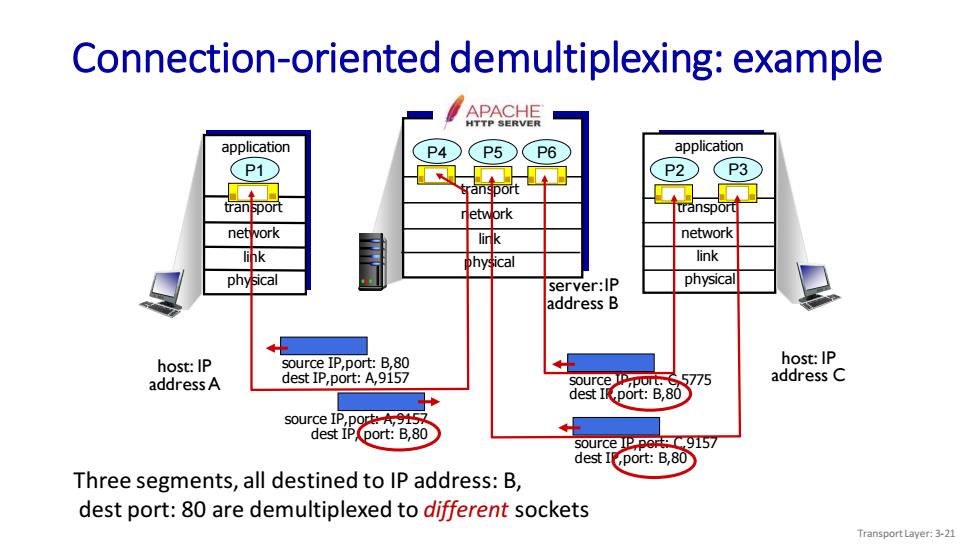
Connection-oriented demultiplexing:example APACHE application P4 P5 (P6 application (P1 P2 (P3 transport transport netvork network link hysical link physical server:IP physical address B host:IP source IP,port:B,80 host:IP address A dest IP,port:A,9157 source IP,port. 5775 address C dest Ik,port:B,80】 source IP,port:A,9157 dest IP/port:B,80 source IP port:C.9157 dest I,port:B,80 Three segments,all destined to IP address:B, dest port:80 are demultiplexed to different sockets Transport Layer:3-21
Connection-oriented demultiplexing: example transport application physical link network P1 transport application physical link P4 transport application physical link network P2 host: IP address A host: IP address C network P5 P6 P3 source IP,port: A,9157 dest IP, port: B,80 source IP,port: B,80 dest IP,port: A,9157 source IP,port: C,5775 dest IP,port: B,80 source IP,port: C,9157 dest IP,port: B,80 server: IP address B Three segments, all destined to IP address: B, dest port: 80 are demultiplexed to different sockets Transport Layer: 3-21
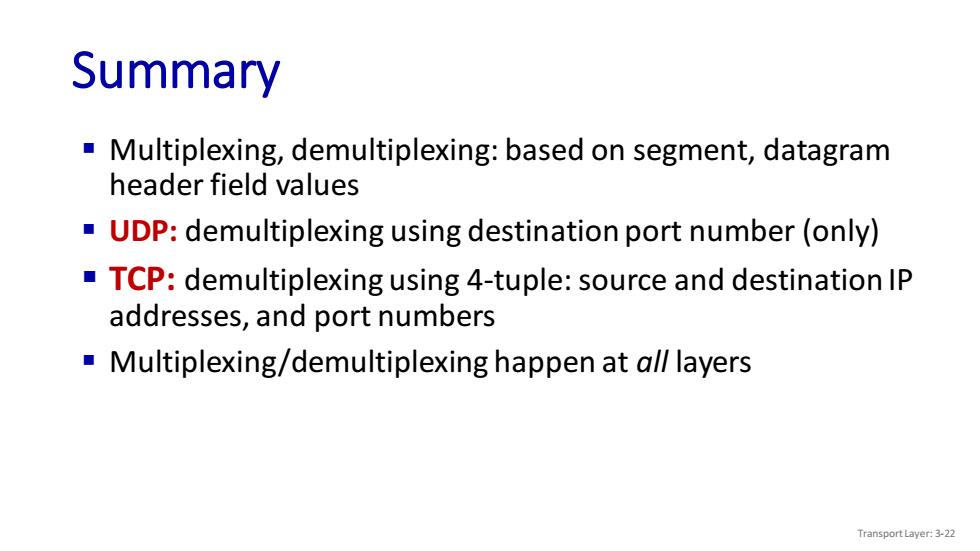
Summary Multiplexing,demultiplexing:based on segment,datagram header field values UDP:demultiplexing using destination port number (only) TCP:demultiplexing using 4-tuple:source and destination IP addresses,and port numbers Multiplexing/demultiplexing happen at all layers Transport Layer:3-22
Summary ▪ Multiplexing, demultiplexing: based on segment, datagram header field values ▪ UDP: demultiplexing using destination port number (only) ▪ TCP: demultiplexing using 4-tuple: source and destination IP addresses, and port numbers ▪ Multiplexing/demultiplexing happen at all layers Transport Layer: 3-22
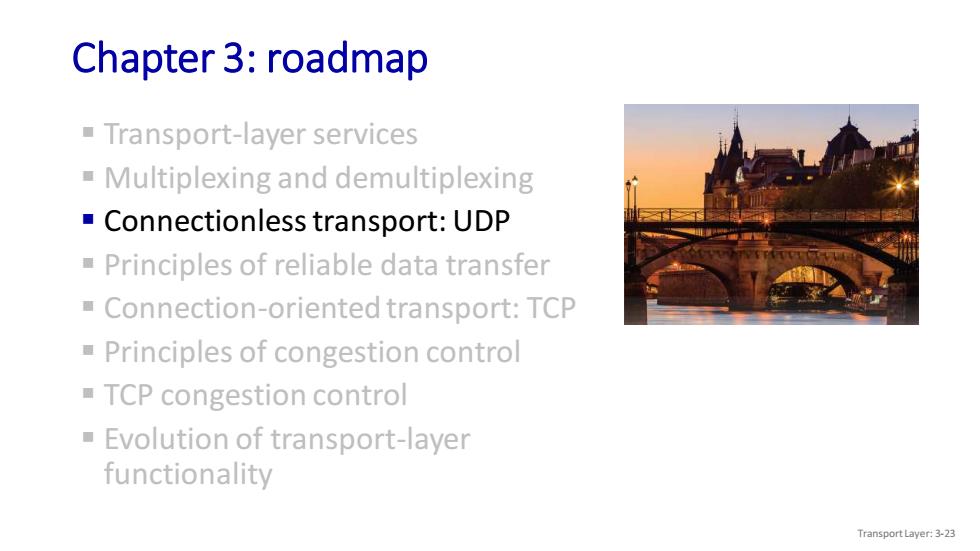
Chapter 3:roadmap Transport-layer services Multiplexing and demultiplexing Connectionless transport:UDP Principles of reliable data transfer Connection-oriented transport:TCP Principles of congestion control TCP congestion control Evolution of transport-layer functionality Transport Layer:3-23
Chapter 3: roadmap ▪ Transport-layer services ▪ Multiplexing and demultiplexing ▪ Connectionless transport: UDP ▪ Principles of reliable data transfer ▪ Connection-oriented transport: TCP ▪ Principles of congestion control ▪ TCP congestion control ▪ Evolution of transport-layer functionality Transport Layer: 3-23
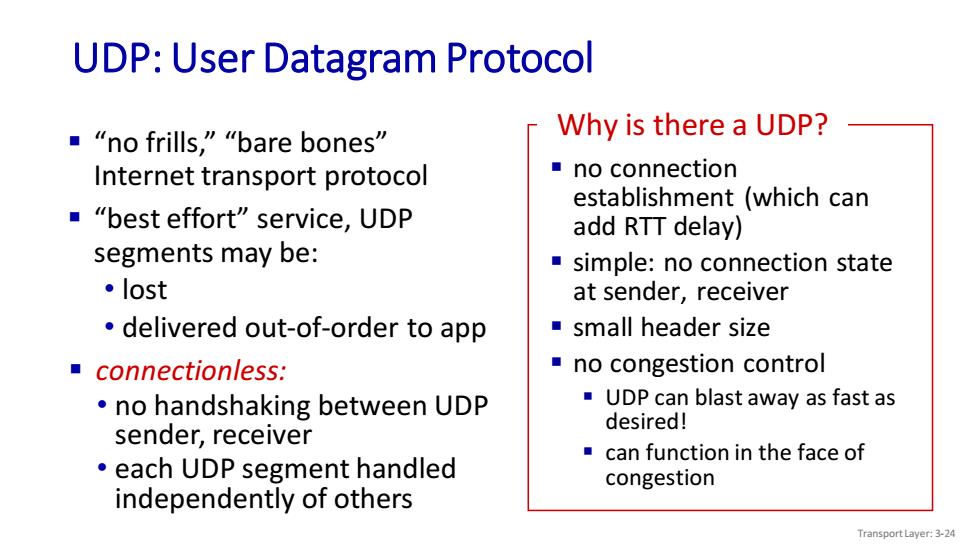
UDP:User Datagram Protocol "no frills,”“bare bones'” Why is there a UDP? Internet transport protocol ■no connection establishment (which can ■“best effort"service,UDP add RTT delay) segments may be: simple:no connection state ·lost at sender,receiver delivered out-of-order to app ■small header size connectionless: no congestion control no handshaking between UDP UDP can blast away as fast as desired! sender,receiver can function in the face of each UDP segment handled congestion independently of others Transport Layer:3-24
UDP: User Datagram Protocol ▪ “no frills,” “bare bones” Internet transport protocol ▪ “best effort” service, UDP segments may be: • lost • delivered out-of-order to app ▪ no connection establishment (which can add RTT delay) ▪ simple: no connection state at sender, receiver ▪ small header size ▪ no congestion control ▪ UDP can blast away as fast as desired! ▪ can function in the face of congestion Why is there a UDP? ▪ connectionless: • no handshaking between UDP sender, receiver • each UDP segment handled independently of others Transport Layer: 3-24
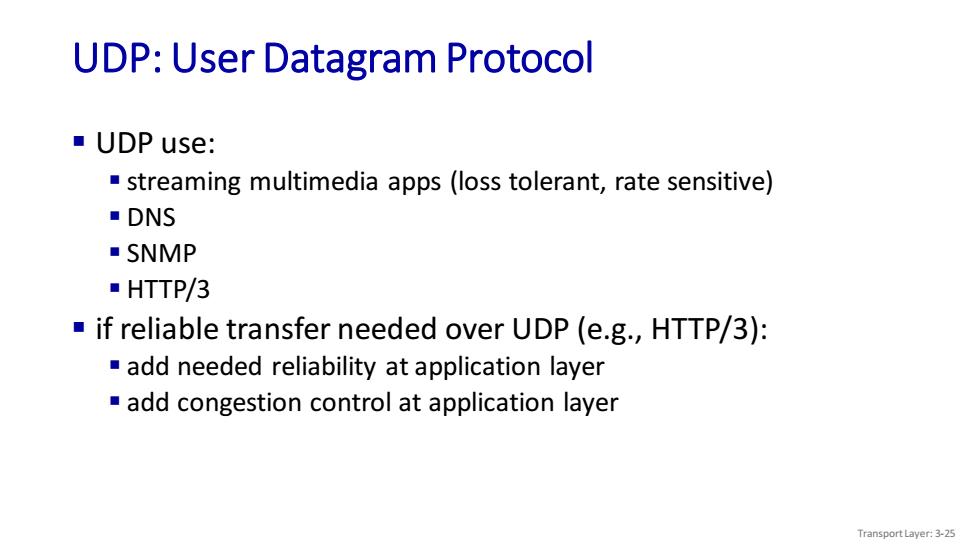
UDP:User Datagram Protocol ■UDP use: streaming multimedia apps (loss tolerant,rate sensitive) DNS SNMP ■HTTP/3 if reliable transfer needed over UDP(e.g.,HTTP/3): add needed reliability at application layer add congestion control at application layer Transport Layer:3-25
UDP: User Datagram Protocol ▪ UDP use: ▪ streaming multimedia apps (loss tolerant, rate sensitive) ▪ DNS ▪ SNMP ▪ HTTP/3 ▪ if reliable transfer needed over UDP (e.g., HTTP/3): ▪ add needed reliability at application layer ▪ add congestion control at application layer Transport Layer: 3-25